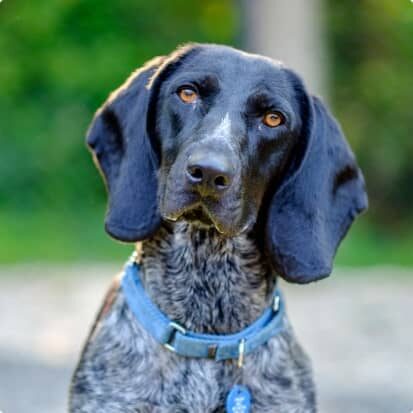Congratulations on selecting your new furry family member! You are embarking on a wonderful new journey that will ultimately bring you loads of fun, love, laughter and a strong source of comfortable companionship. We want to encourage you to keep reading for next best steps to reach this goal with your new puppy.
Here’s a little background on why this packet of information is important. Every dog’s personality/behavior is created by 3 main life components: genetics, early learning (socialization) and on-going life experience. While we can’t always control genetics, we can definitely try our best to ensure that early learning and on-going life experiences are used to our pup’s and our best advantages. To build the strongest trust bond with your puppy, we recommend learning about “Fear Free” or “Positive Reinforcement” methods. The science behind these training ideologies shows that they will help your pup to understand that you have their back. This allows them to build their confidence, emotional resilience and in turn creates a dog willing to explore the world that we humans have created.
Early Learning (Socialization) is a time period of rapid brain development in your pup and can last anywhere from 3-12 weeks of life (up to 16 weeks for some dogs). Any input into their development during this period, good and/or bad, can have lasting effects on their personality (behavioral responses to stimuli). During this time period, we should do our very best to expose them to a variety of stimuli so that they can form good, positive associations and develop a healthy, emotional resilience. Key words in that sentence are “GOOD POSITIVE ASSOCIATIONS”! Exposure for the sake of exposure without the good can actually be detrimental to your puppy’s behavioral health. Learning should also be continued after the socialization period as part of “on-going life experience”. We all need reminders of the things we learned in our early life to help us keep an open and receptive mindset. Same thing goes for our dogs. So how do we go about doing these things?
Socialization can be carried out in a number of ways. Two main important items to keep in mind while going through this process: good, positive associations and protecting your puppy’s physical health. The American Veterinary Society of Animal Behavior (AVSAB, position statement) strongly advocates for early and safe puppy socialization, emphasizing that the critical period for this occurs before full vaccination is complete, typically within the first 12-16 weeks of life. This socialization should involve exposing puppies to a variety of people, places, animals, things and sounds in a safe and controlled manner to prevent behavioral problems later in life (check out the information on Puppy Socialization Bingo and Puppy Jungle Gym for fun ideas). Please confirm with your Veterinarian about your individual puppy’s physical health needs. At minimum, puppies should receive their first set of vaccinations and deworming before starting any socialization classes. So, how do you maintain the physical (biological) safety of your new puppy?
Start by having socialization occur at home. If you have any other furry friends at home, make sure that they are healthy and up-to-date on vaccinations prior to allowing interactions with your new puppy. Have friends come visit your home with the understanding of the “Positive Associations” needed for interactions with your puppy. If you take them to experience the outside world, make sure that you properly transport them to the area where you will do some socialization work, as well as, prepare the area where you will work by creating or selecting a clean working surface. Talk to your vet about the different surfaces that pose a danger to your puppy. Some infectious diseases can support viral vectors for up to 7 years post-exposure. Appropriate, safe surfaces will be those that can be cleaned and/or sterilized, lay a blanket over top, etc. So this means, no dog parks, and no introducing them to dogs that you do not know the information on their health/vaccination status.
How do you know if the interaction is creating a positive association? You need to know how to read your puppy’s body language. What does it mean when a dog is wagging their tail? Spoiler alert, it does not always mean they are happy! It can just be nervous excitement. What does it mean when they roll over and expose their belly? Another spoiler alert, it does not always mean that they want you to rub their tummy. It can actually mean they are scared. Fear Free Happy Homes has a great video on Dog Body Language 101. Check it out so that you can advocate for your dog when things are not going well and hopefully, more likely than not, so you can tell when you are doing things that are making them feel good.
This information packet contains more information on tips and tricks to make puppy socialization fun and hopefully easier. Read on to get more information on creating your Puppy Play Area, Puppy Socialization Bingo, a Puppy Jungle Gym, Potty Training, Crate Training, Nipping/Biting Behaviors as well as other basic training to use for the foundation of helping your puppy to be the best dog they can be. If this resource doesn’t give you the answers you need, please don’t hesitate to reach out to us for help. Don’t forget to look into Puppy Socialization Classes in your area. They are a fun way to get your puppy and you ready to face the world together.
Remember to look for Fear Free and/or Positive Reinforcement trainers/training classes like these places:
Wholistic Hound Academy (Alexandria, VA)
Treats and Triumphs Dog Training (Springfield, VA)
Your Dog’s Friend (Rockville, MD)
Or check out this list of Training Groups and Trainers, vetted by Volunteers at Your Dog’s Friend (advocates for positive reinforcement training). Last, if you’re interested in doing a deep dive into puppy socialization check out these easy to read books. The links are for Amazon but there are many different sources that you can get these resources:
Puppy Socialization: What it is and how to do it by Marge Rogers and Eileen Anderson


